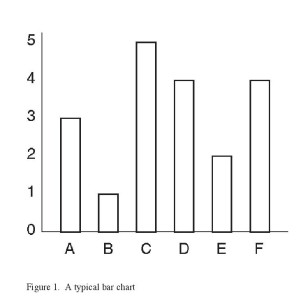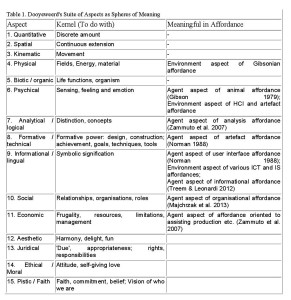IIDE Proceedings 2014 – A Dooyeweerdian Understanding Of Affordance In Information Systems And Ecological Psychology
No comments yetAffordance is attracting considerable interest but it poses significant philosophical challenges, around meaningfulness and the subject-object relationship, as well as less fundamental methodological challenges, such as complexity and translation of idea from one field to another. At this point, the fields in which the notion of affordance is discussed, from ecological psychology to information systems, do not speak to each other and especially in the IS field the treatment of affordance is ad-hoc. This paper discusses how Dooyeweerd’s philosophy can very readily address the philosophical challenges, and provide validation and guidance for the methodological challenges. Dooyeweerd would base affordance in his ‘oceanic’ idea of meaningfulness, and provide a workable definition of affordance as the relationship between two ways of being meaningful (two aspects). The usefulness of this is explored. The paper also discusses some practical applications of a Dooyeweerdian understanding of affordance.
1. Introduction
The idea of affordance has aroused interest in several fields of study of information and communication technology (ICT). Especially in the fields of human-computer interaction (HCI), which focuses on how individuals use ICT, and information systems (IS), which focuses on the benefits of using ICT, affordance was called upon to address issues that had long been found challenging.
In the field of HCI, it was noticed that some designs of the user interface (the screen etc. with which the user interacts in HCI) were easier to use than others – that is, they afforded greater or lesser ease of use. Though ergonomics, psychology, and the amount of skill the user has, affect ease of use, there also seemed to be something about the design and shape of the user interface objects themselves that affected ease (of difficulty) of use. The notion of affordance was harnessed by Norman (1988) and others (e.g. Hartson 2003) to explain this.
More recently, in the field of IS, affordance has been harnessed by several scholars to explain why ICT facilities make specific human activities easier or more difficult, and tend to bring certain benefits rather than others. For example, triggered attending to online conversations (Majckzrak et al. 2013) reduces need to keep watch on conversations, but it can also reduce the depth of engagement. Networked ICT can assist speedy change to documents (Conole & Dyke 2004) but can also bring confusion. Attempts to account for these solely in terms of power relations, attitude or capability of users proved insufficient, because the actual design of the facilities ‘affords’ these activities or benefits.
Originally proposed by J.J. Gibson (1979) in the field of ecological psychology, the idea of affordance shows considerable promise in these fields. It also presents new challenges. Some challenges arise from complexity, some arise from translating the idea from psychology, and some arise from fundamental philosophical issues like the subject-object relation and understanding what affordance is.
This paper discusses these challenges, and explores briefly whether the philosophy of Dooyeweerd can address them. The emphasis will be on affordance in the field of IS more than in HCI or psychology, because of its greater complexity. The idea of affordance and its roots in psychology are explained, with a discussion of how it has been translated across to HCI and IS. Four kinds of challenges are outlined. How these challenges may be addressed by Dooyeweerd’s philosophy is explored, and a few practical examples are given.
2. Affordance
A rock (a flat, horizontal, extended, rigid surface up to knee-high) affords climbing to an animal and a hole in a hedge or wall affords going-through (Gibson 1979, 127): “The affordances of the environment are what it offers the animal, what it provides or furnishes.” The word ‘affordance’ was coined by Gibson to denote a phenomenon that had not been adequately discussed and did not even have a name before, and his exploration of this notion stimulated the field of ecological psychology. The notion of affordance, at root, does not just deal with animals climbing rocks, but with any situation in which an agent interacts with things in its environment – or indeed with the environmental situation as a whole. It addresses issues of perception and what is perceived, of action and possibility, and how these are ‘afforded’ by properties of things in the environment. Gibson (1979, 129) characterizes affordance as “physical and psychical”, in that the physical properties of the environment afford psychical properties like ‘climbability’, which are meaningful to the animal.
The relationship between agent and environment is very similar to that between subject and object. Yet Gibson and other ecological psychologists have found that current presuppositions about subject and object need to be questioned. “Gibson’s concept of affordances was an attempt to undermine the traditional dualism of the objective and subjective” (Costall 2012). Shaw (2003, 93) praised Gibson’s courage: “where most psychologists and philosophers are happy naming the divide the subjective-objective, Gibson would rather we repair the cut entirely by a kind of relational integration”. With Gibson, “one gets subjectivity and objectivity wrapped up in a single package” (Shaw 2003, 97).
The idea of affordance as an attempt to understand the relationship between agent and environment is relevant across many fields. In the field of artefact design, for example, some door handles afford pulling (those that can be grabbed), while others (those that look like plates) afford pushing (Norman 1988). Though plate-like door handles can also be pulled if bent round, they do not invite pulling, and labels saying ‘Pull’ must be installed. What is it about such artefacts that does the affording? How much is social convention, and how much is psychological or even physical?
The field of human-computer interaction faces similar issues (Hartson 2003). The agent is the computer user, and the environment is what of the user interface is seen, heard and manipulated via mouse or finger. What is meaningful to the user is not just these sights, sounds and muscular controls, but the information they carry. For example, a bar chart (a set of long thin rectangles arranged side by side, as shown in Figure 1) is most naturally interpreted by the user as a set of quantities that can be compared. For example, if A-F are nations, then we would expect the numbers 0-5 to indicate population, size of GDP, proportion of land devoted to agriculture, for each nation. However, if the numbers 1-5 indicated religions, main language spoken, this would be possible, but not so natural. The naturalness can be explained by affordance: length of bar affords quantity, not relationship, and proximity of bar affords comparison.
In the field of information systems (IS) the agent is the user and those with whom the user engages, while the environment is the ICT facilities they use – but it is not what the user sees or hears, as in HCI, but the information that is carried via the user interface. It is an informational environment, not physical nor sensory. What they afford is human activities that are meaningful in the life, work and roles of the user. The presence and the shape of ICT facilities available enable or constrain such activities, yielding benefits or problems.
Various kinds of IS affordance have been discussed. For example, Internet-connected ICT affords accessibility to information, speed of change of information, communication etc., but also monopolization and risk (Conole & Dyke 2004). If affords visibility of content, persistence of content, editability of content, and association (Treem & Leonardi 2012). Social media in organisations afford metavoicing (ability to comment on the presence rather than content, e.g. by voting ‘Like’), triggered attending (setting emails or blogs to alert us to certain topics so we don’t need to keep watching), etc. (Majckzrak et al. 2013). ICT in businesses affords visualization of entire work processes, flexible product creation, virtual collaboration, etc. (Zammuto et al. 2007).
Just as in ecological psychology, so in the field of IS, affordance challenges traditional understandings of subject and object, possibility and action. It is hailed by Hutchby (2001) as enabling us, after an era dominated by social constructionist perspectives, to pose questions about the ‘objective’ reality of ICT without falling back into a technological deterministic perspective. However, there are challenges, which are discussed next.
3. Some Challenges
Affordance challenges us in at least four ways. Some arise from the complexity of the IS field itself, especially that of multiple levels of activity, benefit and problem. Some challenges arise from the translation from that field to those of HCI and IS, especially that of accounting for what is common to all fields. Two more fundamental challenges have been widely discussed in the field of ecological psychology, including what affordance actually is, and how agent and environment relate.
3.1 The Challenge of Complexity
If we compare the above affordances of accessibility of information (Conole & Dyke 2004), visibility of information (Treem & Leonardi 2012), triggered attending (Majchrzak et al. 2013) and ability to visualize the entire work process (Zammuto et al. 2007), it is clear that they are of different kinds or levels, leading to confusion or complexity. Is one kind ‘right’ and the others ‘wrong’? Can they all pertain, and if so how do they relate to each other? Are there other kinds yet to be discovered? On what basis may we judge candidates for new kinds of affordance? Moreover, how do these kinds of IS affordance relate to those found in artefact design, HCI and ecological psychology? Such challenges, which arise from complexity, have not yet been discussed in the IS community and possibly not even recognised as issues.
In IS, for each kind of affordance, a list of individual affordances is offered. Such lists are valueless unless we can rely on the list being well-formed or reasonably complete. Most of the authors cited discuss neither completeness nor well-formedness. Yet Mansour et al. (2013) use Treem & Leonardi’s (2012) four affordances of social media as though they are complete – and then come up with four more, but with little discussion of how they relate to each other. When completeness is sought, as by Hartson (2003), over 80 affordances are found, which becomes cumbersome in practice.
3.2 The Challenge of Translating Between Fields
There has been substantial discourse about the nature of affordance in the field of ecological psychology. May we capitalise on that discourse in the IS or HCI fields, by translating concepts and issues across to those fields? If so, how and on what basis? It would seem that the concepts of agent, environment, and a relationship between them that enables or invites activity, is common to all, but this raises further questions.
On what basis is it valid to translate issues or concept from one field to another, and how do we cope with the differences? In HCI and IS, the agent is human and the environment is no longer physical but sensory in HCI and informational in IS. What is the role of the agent’s body, which is of primary importance in ecological psychology. Is there an equivalent of body-scale (e.g. leg length compared with rock height (Warren & Whang 1987; Alsmith 2012)) in IS? Also, issues arise in HCI and IS that are not present in ecological psychology. Rietveld (2008) argues that artefact affordances have a canonical and normative quality, and this carries across to IS, where Conole & Dyke (2004) and Majchrzak et al. (2013) discuss problems as well as benefits afforded by ICT.
3.3 The Challenge of Understanding What Affordance Is
What is affordance? Is it ontological, as Gibson believed, or epistemological, as Norman believed? If ontological several issues emerge in ecological psychology that are relevant to other fields.
Does affordance determine the agent’s activity, or does it “offer” (Gibson 1979, 127), “enable” (Hartson 2003) or “invite” (Withagen et al. 2012) agent activity? What form does the agent’s freedom take (Stoffregen 2000; Chemero 2003; Scarantino 2004)? Likewise, In IS, users of ICT are constrained by its features, yet they often innovatively reinvent use (Boudreau & Robey 2005; Leonardi 2011). Is affordance a property of a distinct object or a feature of a situation (Chemero 2003)? In IS, should we look at the ICT artefact alone, or the situation as a whole. Is affordance perceived, observed or acted on unreflectively? (Withagen et al. 2012; Rietveld 2008) In IS, what is the role of tacit and explicit knowledge in use of ICT facilities?
In what terms should affordance be discussed, as entities, activities, relationships, etc.? Discussion in terms of the interaction of distinct entities (agent and object), like animals, rocks or door-handles, precludes Chemero’s (2003) insight that affordance is of situations. Discussion in terms of activities, like climbing, perceiving, opening, scrolling, associating, editing, tends to place the emphasis back on the agent, and downplays the importance of the environment. Discussion in terms of a relationship between agent and environment leaves open the question of the conceptual terms in which both are to be related: either in terms meaningful to the agent (e.g. climber-climbed) or in terms meaningful to the environment (e.g. force of foot and equal and opposite reaction from rock), which dichotomy misses the point that (in Gibson’s cases) the physical features of the environment relate to the psychical features of the agent.
We need a way of discussing affordance that encompasses all these and more. Behind all the discussion of entities, activities, properties and relationships is concealed a notion that pervades them all, is occasionally mentioned in passing, but is not discussed: meaning or meaningfulness. Schmidt (2007) call’s Gibsons ideas “an ecological theory of meaning”. According to Costall (2012, 87), Gibson had written “a remarkable, though largely forgotten, chapter on meaning, in his first book, The perception of the visual world (1950)”, which “anticipated the concept (of affordance) in several important ways”. Gibson (1950, 199) talked about “use-meanings or meanings for the satisfaction of needs …” Gibson obviously had the idea in of meaning mind, but meaning is not a concept that 1950s psychologists liked to use, and many still resist doing so, so Gibson had to use terms that suggest meaning instead, such as in “what eyes are good for” (Gibson 1966, 155). Gibson (1979) again begins to speak of “the ‘values’ and ‘meanings’ of things in the environment” (p.127), and his “relative to the animal” (his italics) is a meaning concept. Later, Gibson (1982, 407) directly says “The meaning or value of a thing consists of what it affords”.
Those who developed Gibson’s ideas use the term ‘meaning’ often. For example, “an environment consisting of affordance is a meaningful environment” (Withagen & Chemero 2011, 4), “meaning-laden environment … Affordances are meaningful to animals” (Chemero 2003, 182). Gibson “gave us affordances … to account for meaning in the mutuality of the perceiver and environment” (Cutting 1986, 252). In addition, many use other words that imply ‘meaning’, such as: “significance” (Chemero 2003, 182), “animal referential or action referential … refer to some animal, person or group” (Michaels 2003, 139), “relative to the animal … without respect to the animal” (Stoffregen 2000, 9).
In each affordance there are two ways in which the environment is meaningful. In the rock’s own terms, for example, properties like rigid, flat, extended, horizontal are meaningful. But in the animal’s terms, properties like climbable or supportive are meaningful. So Gibson (1979, 129) speaks about such affordance as “both physical and psychical” – meaningful to both physical environment and to animal. “Affordances,” says Chemero (2003, 184), “… are relations between particular aspects of animals and particular aspects of situations.” (An aspect is a way of looking at something.) Affordance may thus be defined in terms of two ways of being meaningful, or a pair of aspects:
* an agent aspect that indicates a way in which the affordance is meaningful to agents,
* a environment aspect that indicates a way in which the affordance is meaningful to the environment that makes the actualization of the agent aspect possible.
How this translates across to other fields is discussed later.
(Note: The concept of ‘agent aspect’ reveals an important distinction between two ways in which the environment is meaningful to the agent: more general and more specific or contingent upon circumstances. In general, the rock is climbable, but the specific reason for climbing might be to flee an enemy, to pursue food, or just to gain a vantage point. “Agent aspect” always refers to the more general meaning, which speaks of the potential of the environment, rather than its specific use.)
Thus affordance may be seen as a pairing of ways of being meaningful. However, it raises the challenge of how the two meanings relate. Chemero (2003) argues that this coupling of non-physical with physical meaning requires a new ontology that “is at odds with today’s physicalist reductionist consensus (in the field of psychology)”. This brings us to the subject-object relationship.
3.4 The Challenge of the Subject-Object Relationship
Affordance as a relationship between agent and environment inherently bridges between subject and object. That affordance must be seen as “relative to the animal” (Gibson 1979, 127) suggests that affordance is subjective. However, “affordance is not bestowed upon an object by a need of the observer and his act of perceiving it; it is always there to be perceived,” located in the environment (p.139), which suggests it is objective. Of this tension, Gibson wrote (p.129):
“an affordance is neither an objective property nor a subjective property, or it is both if you like. An affordance cuts across the dichotomy of subjective-objective and helps us to understand its inadequacy. It is equally a fact of the environment and a fact of behavior. It is both physical and psychical, and yet neither.” (p.129)
A similar tension has been encountered in the IS field. The kinds of affordances discussed above are all, on the one hand, relative to (meaningful to) the user, while on the other hand being located in the environment, i.e. the ICT facilities themselves. Over the past few decades the IS field has increasingly emphasised the former, the subjectivity of IS use (Hartson 2003), including the flexibility with which users can resist use, adopt workarounds or use the facilities in innovative ways. Hutchby (2001) charts the dialectical reactions that have characterized perspectives in the IS field, between emphasis on objectivity with technological determinism, then on subjectivity with social construction of technology and social shaping of technology, and suggests that affordance might offer a next phase, which he calls “technological shaping of sociality”, and which recognises the objectivity of technology alongside the subjectivity of the user. Like Gibson, he wants a reconciliation, and the debate about subject-object in that field can be useful in IS. However, the milieu mitigates against integration of them.
This must be addressed philosophically. Apart from a few passing allusions to Polanyi, James, Wittgenstein etc., Gibson, a radical empiricist, did not attempt a philosophical underpinning. Some have suggested basing Gibson in Heidegger or Merleau-Ponty (Dotov et al. 2012), but the former dissolves rather than “repairs” the difference between subject and object, and the latter’s focus on the body, make them less useful in the fields of ICT and IS. Moreover, neither offer a basis for addressing the diversity of kinds of affordance, nor the both-neither nature of affordance. Dooyeweerd (1955) provides a way to bridge the subject-object gulf without dissolving one into the other, and without undue emphasis on body, so it is useful in IS. This will be explored.
4. A Dooyeweerdian Understanding of Affordance
Dooyeweerd’s philosophy shows promise in understanding affordance. This is because Dooyeweerd came from a different direction, which places meaning at the centre in a way that resonates with the needs of understanding the nature of affordance, and as a consequence can address complexity. Dooyeweerd understands the subject-object relationship in a radically different way that allows genuine integration of subject and object, and addresses the ontology of affordance in a way that can be translated over different fields.
Dooyeweerd argued that most Western philosophers, including both Descartes and Heidegger, have presupposed that the fundamental principle on which all may be explained is to be sought within the created order, and that doing so inevitably divorces meaning from reality and makes it very difficult to address complexity. It also results in philosophical movements of thought being governed by dualistic pre-theoretical presuppositions that lead to deep antinomies in philosophy. The dualism that governs the current era, to which both Descartes and Heidegger belong, is the opposition of (deterministic) nature and (human) freedom. The Cartesian subject-object relationship is an expression of this, presupposing an unbridgeable gulf between (freely-perceiving) subject and (perceived) object so, Dooyeweerd argued, much as philosophers might try to bridge the gulf they will ultimately always be unsuccessful because their opposition is presupposed (Dooyeweerd 1955,I,64-65).
Resolution requires adopting different presuppositions. By presupposing that the fundamental principle lies outwith created reality, meaning is re-integrated with reality, and his philosophy is not dualistic but recognises a pluralistic diversity that coheres. This opens the way for a radically different idea of subject and object, which provides what Gibson was reaching for.
4.1 Addressing the Challenge of What Affordance Is
Dooyeweerd held that meaningful law is the transcendental foundation of all being, becoming, activity, possibility, knowing and rationality. He wrote:
“Meaning is the being of all that has been created and the nature even of our selfhood.” (Dooyeweerd 1955, I, 4, his italics)
Meaning, in this sense, must be differentiated from subjective or intersubjective attribution of meanings to things, and from linguistic semantics or pragmatics. It is akin to what is referred to in “the meaning of life” – something beyond us, and to which all refers. Meaning in Dooyeweerd’s sense will be called ‘meaningfulness‘ here. Meaningfulness is like an ocean in which fish swim, and which at the same time enables their swimming and even enables them to be fish. It is this ‘oceanic’ view of meaningfulness that is helpful for understanding affordance. Meanings, in the sense of specific attributions or significations, are made possible by this ‘ocean’ of meaningfulness. (It may be argued that what Heidegger did for existence, Dooyeweerd did for meaningfulness. Meaningfulness is not something we stand apart from, control or generate, as a property of objects, but something we ‘live within’, and we actualize or ‘discover’ it by living or occurring within it.)
In everyday experience we encounter a rich diversity of meaningfulness – physical meaningfulness, biotic, psychical, purposeful, informational, social, economic, aesthetic meaningfulness, and so on. Most philosophy has divorced meaningfulness from reality (Dooyeweerd 1955, II, 25-26) and thus has had little incentive to explore this diversity, so instead tries to reduce it to just a couple of aspects (ways of being meaningful). Dooyeweerd, by contrast, was motivated to do justice to our everyday experience and explore the diversity philosophically. In a discussion of over 400 pages in Dooyeweerd (1955, II), he delineated fifteen aspects or fundamental ways of being meaningful. These are shown in Table 1, below, each of which is irreducibly distinct from the others, and the laws of which cannot be reduced to the laws of others.
Dooyeweerd addresses the debate over whether affordance should be approached as entities, activities or relationships, by grounding all three in a deeper notion of aspectual meaningfulness. Genuine existence presupposes meaningfulness. For example, a rock exists qua rock by reference to the physical aspect, and becomes rock by responding to laws of the physical aspect (which govern forces, energy, etc.). A climbable-thing exists qua climbable-thing by reference to the psychic aspect. An ICT system has no existence qua ICT system, and does not become an ICT system, except by reference to the informational (‘lingual’) aspect and its laws. Reference solely to the physical silicon, copper and plastic from which its hardware is constructed does not account for the ICT system. For fuller discussion of this, see Chapter V of Basden (2008). Each thing is a thing by reference to at least one aspect.
To Dooyeweerd, aspectual existence accommodates, but does not presuppose, distinct entities. Physical, social and aesthetic existence especially are often beyond entities, and are more properly called situations. But biotic and analytical existence especially are often discrete.
Likewise, activity presupposes meaningful law that defines and enables functioning and repercussions of that functioning (‘causality’). Climbing, qua climbing, as opposed to exerting-force-on-horizontal-flat-rigid-rock, presupposes the sphere of meaningfulness that is psychical. Likewise, editing text, qua editing text, presupposes the lingual, and collaboration, qua colaboration, presupposes the social. To Dooyeweerd, this is not just epistemological (in that we call such activity “climbing”, “editing” and “collaboration”), but it is ontological, in that climbing, editing and collaboration actually occur, and are not ontologically reducible to physical functioning such as exerting forces. (Arguing that requires more space than is available here.) Relationships also presuppose such aspects, in that the kind of relationship that is meaningful depends on the aspect.
This implies that each thing, activity and relationship that we encounter in the pre-theoretical (everyday) attitude actually exhibits multiple aspects. So, for example, the rock is both rock by reference to the physical aspect, and also at the same time, climbable-thing by reference to the psychical aspect. An ICT system exhibits many more aspects, discussed in Chapter V of Basden (2008). This informs the debate over whether perception of the environment is reflective or unreflective. It would be addressed by Dooyeweerd as the agent and environment functioning together in response to aspectual law. In the analytical aspect perception can be reflective, but in the psychical, formative, lingual, social and other aspects, it is unreflective (c.f. Basden 2008, 93).
Repercussions of functioning in the quantitative to physical aspects are largely deterministic, but are increasing non-deterministic in the later aspects, instead taking on a normative quality. In the case of the climbing animal, the psychical activity of its climbing will not be deterministic, even though the physical activity of contact between foot and rock functions largely deterministically. That later aspects are even less determinative can inform the debate over whether affordance offers or invites, rather than determines, activity.
Conventionally, each discipline or science focuses its gaze on one way of being meaningful (one aspect) and studies that (Basden 2008, 100). The temptation is strong to ignore all but the one aspect or to try to reduce phenomena meaningful in other aspects to those meaningful in their main aspect. The temptation to reduce psychical activity like climbing to physical activity is strong, but Gibson wanted to resist it. Yet the intellectual milieu of the time made it difficult for him. It still does. Dooyeweerd can provide sound philosophical support for Gibson’s resistance – and also equivalent resistance in the IS field.
4.2 Addressing the Challenge of Complexity
Dooyeweerd’s notion of aspects as ways in which things are meaningful can address the complexity of kinds of affordance, and also affordances within each kind. Whereas meaningfulness has been problematic in psychology, it has long been recognised in the field of IS for some time, for example via the Weltanschauung of Soft Systems Methodology (Checkland 1981), the hermeneutic circle of interpretive IS research (Klein & Myers 1999) and the semantics and pragmatics of knowledge engineering (Basden & Klein 2008). However, meaningfulness has seldom been discussed as such, having been largely taken for granted.
Dooyeweerd’s exploration of the diversity of meaningfulness offers a basis on which to address the complexity of IS (see, e.g., Bergvall-Kåreborn & Grahn 1996; Eriksson 2006). All situations exhibit all aspects, either actually or latently, and identifying how it is meaningful in each aspect helps to separate out issues, draws attention to issues that have been overlooked, and helps to prevent category errors. If each affordance is a pair of ways of being meaningful, then we might expect many possible pairs, each being characteristic of a different kind of affordance. In artefacts, the agent aspect is the formative (achievement of some task like opening a door), while the environment aspect is the physical. In HCI, the environment aspect is the psychical aspect, i.e. things that are seen, heard or controlled by muscular action, while the agent aspect is the informational, insofar as the user’s seeing, hearing or manipulating is not for its own sake but always signifies something.
In the IS field as described earlier, the environment is informational, but the agent aspect is different in each case, and this provides a way to differentiate them. Zammuto et al. (2007) are primarily interested in how ICT affords benefits to the product-oriented organisation, such as flexible product creation and mass collaboration to achieve some productive end. These focus largely on the economic aspect. They also discuss visualization (of the entire work process), which is analytical. Majckzrak et al. (2013) are interested in how social media in organisations afford metavoicing, triggered attending, network-informed associating, etc. which are primarily meaningful in the social aspect. Treem & Leonardi (2012) are primarily interested in issues meaningful in the formative aspect of achievement, such as visibility, persistence, editability. Conole & Dyke (2004) are interested in general ICT-related possibilities, many of the meaningful in the lingual aspect.
Hutchby (2001) argues that affordance depends on a relationship between human activities and technological features, rather than on either separately, and that studying either informational or organisational aspects on their own is not helpful. However, these authors show that in the IS field the agent aspect varies, being respectively the economic,
social, formative and informational. This increased complexity can be addressed by reference to Dooyeweerd’s suite of aspects. Table 1 shows each aspect with its kernel meaning, and how each aspect might be an agent aspect or environment aspect for each kind of affordance in both IS and other fields.
This shows several things. One is that each kind of affordance discussed above can be situated within such a scheme. This provides a more general way of understanding affordance in general across all fields. It also shows that there is room for other kinds to be discovered. This provides an incentive to seek others and a basis on which candidate kinds of affordance may be judged – see later examples in which the agent aspect is the aesthetic or ethical. The fact that some aspects are both agent aspect for one kind of affordance and environment aspect for another suggests a way of relating different kinds of affordance together. Specifically, one kind of affordance might ‘serve’ or ‘enable’ another and, conversely, one kind might depend on another. For example, HCI affordances can serve IS use affordances. This dependency has been discussed by Dooyeweerd as interdependency among aspects, where each aspect depends foundationally on earlier ones insofar as functioning in that aspect depends on good functioning in the earlier aspect (e.g. social functioning requires lingual functioning of communication).
Aspects have a normative quality, with each aspect defining a distinct kind of good and bad. For example, lingual good includes understandability, social good and bad include togetherness versus enmity, and economic good and bad include frugality versus waste (Basden 2011). This can be a basis for studying the normativity that Rietveld (2008) found in artefact affordances and which pervades IS affordances. Sometimes, IS affordance seems to exhibit more than two aspects. For example, visualization of entire work processes, though it might serve economic purposes, seems mainly meaningful in the analytical aspect (visualization) and also the aesthetic aspect of harmony (“entire”). By prompting a decision on which aspect is intended to be primary, with appropriate rewording, Dooyeweerd’s aspects are useful in removing possible category errors. Dooyeweerd recognised that multiple aspects could be important, in his distinguishing between qualifying, founding, leading and internal-leading aspects. In most cases, the founding aspect aligns with the environment aspect, and the qualifying aspect with the agent aspect, but that does not always work, because Dooyeweerd assumed that the founding aspect is always earlier, whereas we have one case in which the agent aspect is analytical, earlier than the lingual environment aspect. Dooyeweerd’s theory of roles of aspects seems underdeveloped (Basden 2008), and might benefit from study of a wide range of IS affordances.
4.3 Addressing the Challenge of Subject and Object
If we are to circumvent the problem of the Cartesian subject-object relationship, we need to understand what makes it problematic. Dooyeweerd (1955) located its root problem in pre-theoretical commitment to a dualism between nature and freedom, and this influenced the thought of both Descartes and Heidegger. Descartes’ subject is presupposed to be free in its perceiving, thinking and acting, while his object is presupposed to be largely passive and unfree – of the nature pole. Heidegger could only remove the tension between subject and object by ignoring one of them, but this ultimately fails to fit everyday experience, in which subject and object both occur and neither can be ignored.
Dooyeweerd could overcome the tension while retaining both subject and object by recognising that, to be a subject (agent) is constituted in being subject to law (thus re-integrating the two English words ‘subject’). Law does not refer to subjectively or socially constructed laws, rules or norms, whether spoken or unspoken, but to the deep law that enables reality to Be and Occur, and by which Time itself is generated. Law often takes the form of promise, and is different for each aspect; for example, a law of the lingual aspect might be expressed as “If we make sense in terms of what the reader already assumes or believes, then the reader will understand better”. What Dooyeweerd called the law side of reality includes the deep laws of all aspects together.
All functioning in temporal reality is governed and made meaningful by this aspectual law, but subjects and objects function differently. Things function as subject (agent) when they respond to law, and as objects when their functioning, though still governed by law, is as a result of some agent’s subject-functioning. For example, as I write this I am responding to laws of the lingual aspect, and thus function as lingual subject, but the words and sentences I write are functioning as lingual objects. The expected reader is also a lingual subject; Dooyeweerd’s view enables a subject-subject as well as subject-object relations. So, as ICT is used, the words and other symbols they read or write are lingual objects while they, as lingual subjects, actively respond to lingual law. Likewise, when considered from the psychical aspect, the animal functions as subject when they climb, and the rock functions as psychical object in being climbed.
Agent and environment are governed, and their functioning enabled, by the same law side. However, they function differently in different aspects. To Dooyeweerd, whether an entity is a subject or object does not depend on the entity itself, but on how it functions in each aspect. An entity can be subject in one aspect but object in another, as in the example of the animal climbing a rock:
* The climbing animal functions as subject in both psychical (seeing, hearing, responding as climbing) and physical (feet exert force) aspects. The human user of a computer functions as subject in all aspects.
* The climbable rock functions as object in the psychical aspect (‘letting itself’ be climbed) but as subject in the physical (exerting equal and opposite force). Likewise, a computer may be said to function as subject in the physical aspect of silicon etc., but as object in the lingual, social and economic aspect.
This provides philosophical grounding, which has so far been lacking, for the idea that agent-relative properties like climbability or editability are located in the environment, without having to reduce the agent aspect to the environment aspect, and without having to posit it as being solely in the intentions or constructions of the agent. Unlike the Heideggerian escape, of merely dissolving the difference between subject and object, Dooyeweerd retained the distinction, which is found in everyday life and is also important for affordance. Dooyeweerd’s understanding of subject and object provides the foundations for the bridge that Gibson and others have so long sought. It also enables IS scholars to conceive of how the information (‘technical’) characteristics of the ICT facilities have a role to play in response to the ‘free’, innovative activity of the user, without fear of returning to a technological determinism in which only the technology plays a role.
4.4 Addressing the Challenge of Translation to Different Fields
This provides a sound basis for translating the insights from ecological psychology across to other fields – and vice versa. For translation to be valid there must be some common thread that can be made the basis for translation. Chemero’s (2003) suggestion that affordance is a relationship between a pair of aspects, combined with Dooyeweerd’s notion of aspects, helps to generalise the idea of affordance across all fields, as a pairing of agent and environment aspects in each case.
Dooyeweerd’s suite of aspects provides a useful conceptual tool with which to think about the different pairings. Dooyeweerd’s notion of multiple aspects of one activity means that when extra aspects are encountered they can be incorporated rather than ignored. Aspects are understood in the same way, as ways in which things can be meaningful, and meaningfulness is understood in the same way, as an ‘ocean’ that enables us to Be and Occur. This grounds entities, activities and relationships of affordance across all aspects, as explained above.
What differs through the aspects, and thus what influences the way issues encountered in one kind of affordance are translated to others, are three things: the precise meaningfulness that each offers, that the laws of earlier aspects are more deterministic than the more normative laws of later aspects, and that functioning in later aspects depends on that in earlier ones for its actualization. The following are issues discussed above:
* Activity. Each agent aspect enables a distinct kind of activity, but this is likely to be more varied and less predictable in IS than in ecological psychology.
* Normativity. This should be expected in all kinds of affordance, though in than psychical affordance normativity is minimal. That normativity differs for each aspect provides clarity.
* Enabling. Functioning in the environment aspect enables that in the agent aspect. This can often be understood in terms of Dooyeweerdian interdependency between aspects.
* Unreflective perception. The knowing in most aspects is unreflective, but takes a different form.
Formative, lingual and social perception all differ, but are all present in IS use, so understanding the difference can help study.
In ecological psychology, the body is important, and body-scale is a key concept. How might this translate across to information systems? There have been two main ways, neither of which are ideal. One approach is to ask where ‘bodies’ are found in IS, such as in avatars in virtual reality or characters in computer games. This can lead to confusion, as in (Rambusch & Susi 2008) and is limited in application. Another is to seek analogies to the body, as Bloomfield et al. (2010) do, taking Scarry’s (1985) view that made objects are projections of the human body (e.g. bandage replaces skin). Then “Such ‘affordances’, we might say, name the various ongoing exchanges of attributes between human bodies and the world made of objects” (Bloomfield et al. p.421). But they provide no precision, as the “we might say” indicates, and arguments cannot be based on analogies.
Seeing affordance as meaningfulness opens up a third, more satisfactory way. This involves we asking why body scale is important (meaningful) in ecological affordances: It is because of the physical and pre-physical properties of the animal – how the animal is meaningful in terms of the environment. That is, the environment aspect in which both agent and environment function are compared. Usually a subject-subject relationship is discovered in this aspect, which is the basis for genuine interaction. In the IS field, we can likewise compare the environment aspect of both user and ICT facility. Several affordances are founded in information (Dooyeweerd’s lingual aspect), so the equivalence of body scale is: What are the lingual (informational) characteristics of the afforded human task, and how do they compare with those available in the ICT facility? One example might be language difference, which can hinder social affordance.
5. Practical Application
A few examples are now offered of how this might work in practice. Aspectual normativity provides a way to separate out issues (Ahmad & Basden 2013) and locate more precisely where the problems might lie. For example, information overload (Conole & Dyke 2004) is problematic by reference to the lingual aspect but not the formative, while groupthink (Majchrzak et al. 2013) is problematic by reference to the social and pistic aspects, but possibly not directly problematic in the economic aspect. Dooyeweerd’s aspects are intended to apply across all cultures, and to be intuitively grasped. This opens up the possibility of distinguishing affordances that are culturally specific from those which apply across all cultures. To understand affordances which apply across cultures is very important when considering ethical and beneficial development in which ICT plays its part.
Some extant lists of affordances are incomplete or not well formed, and aspects can help reveal and even correct these. In the ideal case, all affordances of a given kind should have the same agent and environment aspects, but may be differentiated from each other by a tertiary aspect. This can help prompt critique and refinement of lists, as in the following example, which critiques Zammuto et al.’s (2007) five affordances of: Visualizing entire work processes, Flexible product creation, Virtual collaboration, Mass collaboration, and Simulation and synthetic representation (what-iffing). For all these, the environment aspect is the lingual. From the way they are worded, each is meaningful in a different aspect, respectively: analytic/aesthetic, formative, social, social and analytic.
If this is the agent aspect, then the list is not well-formed. However, examination of their explanation of each shows that each is related to the economic functioning of a product-oriented organisation, so these aspects might be the tertiary ones. The dual aspect in visualization suggests the affordance can be meaningfully split, one dealing with analysis of work processes, the other with harmonizing them. The two social aspects prompts a question of whether there is any important difference between virtual and mass collaboration. The text reveals that though both involve collaboraton, which is indeed social, the emphasis in the former is on communication and in the latter is on working together, suggesting lingual and social aspects respectively. The ‘virtual’ tag, though fashionable in IS circles, is not useful as a differentiator since most of their affordances involve virtuality. It might be useful to relabel both.
Dooyeweerd’s suite of aspects can help direct search for new kinds of affordance. Table 1 contains aspects for which no IS affordance has yet been discussed – aesthetic to pistic – which suggests possible new kinds of affordance. The way to begin to consider these is to assume an environment aspect of lingual, but an agent aspect of each of these, and ask for each “What benefits or problems meaningful in this aspect would the user experience?” For the aesthetic aspect, such benefits might be fun or enjoyment. “How can ICT facilities afford fun?” is an IS question, to which Dooyeweerd can direct our attention. Computer games are a genre dedicated to this, so exploration of aesthetic-lingual affordances might begin there.
Though Rambusch & Susi (2008) try to discuss affordances in computer games, but their treatment is confused, and can be an example of how a Dooyeweerdian approach can remove confusion. They mix together affordances that are meaningful to the avatar (opening a door in a virtual room) with those meaningful to the human player (keyboard buttons), and yet they miss the main point of computer gaming: fun. Using Dooyeweerd’s aspects, Breems & Basden (2014) are able to distinguish these as: opening a virtual door in a virtual room is ‘engaging with meaningful content’; hitting keyboard buttons is ‘human-computer interaction’, and having fun is ‘human living with computers’, and all three involve all aspects, though in different ways.
Finally, aspectual affordance might provide insight into societal and developmental issues. Recognising that no affordance has been discussed in which the ethical is the agent aspect (Table 1), this directs our attention to the question, “How can ICT facilities afford self-giving attitudes such as generosity?” Attitude is not just individual but also pervades society in ways that are not obvious, but which become felt after a time. So this affordance needs to take a societal perspective. This is especially important in development ethics. Generosity is an attitude which pervades Sub-Saharan Africa, but which by comparison is lacking in the wealthy, European North. This directs us to the important question of the impact of ICT on African attitudes, whether it will afford a strenghthening or weakening of such generosity, and how to strengthen rather than weaken. Given the individualized nature of mobile ICT, this is a serious challenge. Much will depend on whether the ICT available for use there is self-protective or tends to open up self. The tendency of application developers to self-protection of economic and legal interests is likely to afford a turn to selfishness and self-centredness, undermining traditional generosity. There is much other potential applicability, such as how the Dooyeweerdian idea of affordance can guide research agendas, and how it can be used to bring disparate kinds of affordance together into a wider picture. Those are still to be explored.
6. Conclusion
Affordance is a useful notion with which to think about and discuss the relationship between an agent and its environment across many fields – whether animals in a physical environment, or people using ICT facilities in an organisation. Several challenges have been mentioned: complexity and different kinds of affordance, the translation of concepts and findings about affordance from one field to others, and two more fundamental challenges, those of meaningfulness and of the subject-object relationship.
Dooyeweerd’s philosophy is ideal for grounding an understanding of affordance, because the two main fundamental challenges that affordance presents are directly and centrally addressed by Dooyeweerd, and the other two challenges are addressed on the basis of those. To Dooyeweerd, meaningfulness is foundational to all, and his exploration of diversity of meaningfulness, which resulted in his famous suite of fifteen aspects, can be very helpful in understanding affordance as the relationship between pairs of aspects. Until now, though the discourse around affordance frequently mentioned meaning, there was little understanding of meaning as such. Dooyeweerd’s reinterpretation of the subject-object relationship enables us to understand how agent-relative features like climability or editability can be located in the environment rather than solely in the agent. A number of issues that depend on these foundational ones have been also discussed, and some practical examples have been given for how Dooyeweerd might be useful when discussing affordance.
This might make a number of contributions. The field of ecological psychology might benefit from a philosophical grounding to the concepts that circulate in its discourse, as well as from a confidence that there is at least one philosophy that can support both Gibson’s desire to bridge between subjective and objective and the growing importance of meaning. The field of IS can benefit from recognising distinct kinds of affordance as defined by different agent aspects. Dooyeweerd’s suite of aspects can direct research into new kinds of affordance. The generation of lists of affordances of each kind can benefit from reference to aspects. The idea that the environment aspect is the lingual rather than the physical provides a starting point for translating insights emerging from the field of ecological psychology into the field of IS. In these ways, IS research into IS use can be strengthened and given a firmer foundation.
Acknowledgements
I would like to thank Darek Haftor and Maarten Verkerk for very valuable comments on drafts of this paper, which prompted a major rethink and rewrite.
NOTES
i. Andrew Basden – Salford Business School, University of Salford, Salford, UK – A.Basden@salford.ac.uk
REFERENCES
Ahmad, H. & Basden, A. 2013. Down-to-Earth Issues in Information System Use. Proceedings of the Pacific Area Conference on Information Systems (PACIS). Paper 191.
Alsmith, A. 2012. The concept of a structural affordance. AVANT, III(2), 95-107.
Basden A. 2008. Philosophical Frameworks for Understanding Information Systems. IGI Global Hershey, PA, USA.
Basden, A. 2011. A Presentation of Herman Dooyeweerd’s Aspects of Temporal Reality. International Journal of Multi-aspectual Practice, 1(1), 1-28. Available at “http://www.dooy.info/papers/ijmap/”.
Bergvall-Kåreborn, B. and Grahn, A. (1996). “Expanding the Framework for Monitor and Control in Soft Systems Methodology” Systems Practice 9:469-495.
Breems, N., Basden, A. (2014). Understanding of computers and procrastination: A philosophical approach. Computers in Human Behavior, 31(2014), 211-223.
Basden, A. & Klein, H.K. (2008) New Research Directions for Data and Knowledge Engineering: A Philosophy of Language Approach. Data & Knowledge Engineering, 67(2008), p.260-285.
Bloomfield, B.P., Latham, Y., Vurdubakis, T. (2010). Bodies, technologies and action possibilities: When is an affordance? Sociology, 44, 415-433.
Boudreau, M-C. Robey, D. (2005). Enacting integrated information technology: a human agency perspective. Organization Science. 16(1), 3-18.
Checkland, P. (1981). Systems Thinking, Systems Practice, Wiley, New York.
Conole, G. & Dyke, M. (2004). What are the affordances of information and communication technologies? Alt-J, Research in Learning Technology, 12(2), 114-124.
Costall, A. (2012). Canonical affordances in context. AVANT, III(2), 86-93.
Cutting, J.E. (1986). Perception with an eye for motion. MIT Press, Cambridge, MA, USA.
Dooyeweerd H. (1955). A New Critique of Theoretical Thought, Vol. I-IV, Paideia Press (1975 edition), Jordan Station, Ontario.
Dotov, D.G., Nie, L., de Wit, M.M. (2012). Understanding affordances: history and contemporary development of Gibson’s central concept. AVANT, II(2), 28-39.
Eriksson DM (2006) “Multimodal Investigation of Technology-Aided Human Practice in Business Operations” pp.165-184, In: Strijbos S. and Basden A. (eds.) In Search of an Integrative Vision for Technology: Interdisciplinary Studies in Information Systems. Springer.
Gibson, J.J. (1950). The perception of the visual world. Boston: Houghton-Mifflin.
Gibson, J.J. (1966). The Senses Considered as Perceptual Systems. Boston: Houghton-Mifflin.
Gibson, J.J. (1979). The Ecological Approach to Visual Perception. Boston: Houghton Mifflin.
Gibson, J.J. (1982). Notes on affordances. In: E. Reed, 8 R. Jones (Eds.), Reasons for realism: The selected essays of James J. Gibson (pp. 401- 418). Hillsdale, NJ: Erlbaum.
Hartson, H.R. (2003). Cognitive, physical, sensory, and functional affordances in interaction design. Behavior & Information Technology, 22(5), 315-338.
Hutchby, I. (2001). Technologies, texts and affordances. Sociology, 35(2), 441-56.
Klein, H.K., Myers, M.D. (1999). A Set of Principles for Conducting and Evaluating Interpretive Field Studies in Information Systems. MIS Quarterly 23(1), 67-93.
Leonardi, P.M. (2011). When flexible routines meet flexible technologies: affordance, constraint, and the imbrication of human and material agencies. MIS Quarterly, 35(1), 147-67.
Majchrzak, A., Faraj, S., Kane, G.C., & Azad, B. (2013). The contradictory influence of social media affordances on online communal knowledge sharing. Journal of Computer-Mediated Communication, 19, 38-55.
Mansour, O., Askenäs, L., Ghazawneh, A. (2013). Social media and organizing – an empirical analysis of the role of Wiki affordances in organizing practices. Thirty Fourth International Conference on Information Systems, Milan 2013.
Michaels, C.F. (2003). Affordances: Four Points of Debate. Ecological Psychology, 15(2), 135-148.
Norman, D.A. (1988). The Psychology of Everyday Things. Basic Books, New York, USA.
Rambusch J. & Susi T. (2008). The challenge of managing affordances in computer game play. HUMAN IT (publ. University College of Borås), 9(3), 83-108.
Rietveld, E. (2008). Situated normativity: the normative aspect of embodied cognition in unreflective action. Mind, New Series, 117(468), 973-1001.
Scarantino, A. (2004). Affordances Explained. Philosophy of Science 70, 949-61.
Scarry, E. (1985). The Body in Pain: The Making and Unmaking of the World. Oxford: Oxford University Press.
Schmidt, R.C. (2007). Scaffolds for social meaning. Ecological Psychology, 19(2), 137-151.
Shaw, R. (2003). The agent-environment interface: Simon’s indirect or Gibson’s direct coupling? Ecological Psychology, 15(1), 37-106.
Stoffregen, T. (2000). Affordances and events. Ecological Psychology, 12, 1-8.
Treem, J.W. & Leonardi, P.M. (2012). Social media use in organisations: exploring the affordances of visibility, editability, persistence and assocation. Communication Yearbook, 36.
Warren, W.H., & Whang, S. (1987). Visual guidance of walking through apertures: Body-scaled information for affordances. Journal of Experimental Psychology: Human Perception and Performance, 13(3), 371-383.
Withagen, R. & Chemero, A. (2011). Affordances and classification: on the significance of a sidebar in James Gibson’s last book. Philosophical Psychology, 2011, 1-17
Withagen, R., de Poela, H.J., Arafijob, D., Pepping, G-J. (2012). Affordances can invite behavior: reconsidering the relationship between affordances and agency. New Ideas in Psychology, 30, 230-258.
Zammuto, R.F., Griffin, T.L., Majchrzak A., Dougherty, D.J., Faraj S. (2007). Information Technology and the Changing Fabric of Organisation. Organisation Science, ‘8(5), 749-62.
You May Also Like
Comments
Leave a Reply












